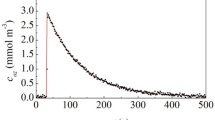Abstract
The use of the mortar and pestle in the laboratory dates back to the earliest attempts to understand and use the materials around us. Even now, it is difficult to imagine an alternative to crushing and grinding for the preparation of many samples. Traditionally, mortar-and-pestle mixing or grinding has been held to be a relatively mild and controlled process, although it was recognized that the grinding of materials harder than the material of the mortar and pestle would result in some contamination. Thus, good practice forbade grinding of, for example, mullite and alumina in agate mortars. That this technique is not so innocuous was demonstrated by Dachille and Roy1 with respect to the stresses generated. They showed that phases usually obtained only at 10–20 kbar can be obtained metastably by simple grinding in a laboratory mortar. There are numerous examples of solid–state phase transformations being produced by prolonged or intense comminution2, two of the best–documented cases of stress/shear–induced transformation being the conversion of calcite to aragonite1, and of quartz to amorphous silica3,4, both by prolonged grinding in a laboratory mortar and pestle. Here we show that the very small amounts of material generated by the wear of mortar and pestle surfaces by even mild grinding can also have substantial effects on the micro-structure and transformation kinetics of certain ceramic systems so treated.
This is a preview of subscription content, access via your institution
Access options
Subscribe to this journal
Receive 51 print issues and online access
$199.00 per year
only $3.90 per issue
Buy this article
- Purchase on Springer Link
- Instant access to full article PDF
Prices may be subject to local taxes which are calculated during checkout
Similar content being viewed by others
References
Dachille, F. & Roy, R. Nature 186, 34–71 (1960).
Lin, I. J., Nadiv, S. & Grodzian, D. J. M. Miner. Sci. Engng 7, 313–336 (1975).
Ray, R. C. Proc. R. Soc. A 102, 640–642 (1923).
Dale, A. J. Trans. Br. ceram. Soc. 23, 211–216 (1923).
Ervin, G. & Osborn, E. F. J. Geol. 59, 331–384 (1951).
Roy, D. M. Am. Miner. 39, 140–143 (1954).
Suwa, Y., Roy, R. & Komarneni, S. J. Am. ceram. Soc. (in the press).
Roy, R., Suwa, Y. & Komarneni, S. in Ultrastructure Processing of Ceramics, Glasses and Composites (eds Hench, L. L. & Ulrich, D. R.) (Wiley, New York, 1984).
Suwa, Y., Komarneni, S. & Roy, R. J. Mater. Sci. Lett. 5, 21–24 (1986).
Yarbrough, W. A. & Roy, R. J. Mater. Res. (submitted).
Guglielmi, M. & Principi, G. J. Non-Cryst. Solids 48, 161–175 (1982).
Gregory, A. G. & Veasey, T. J. J. Mater. Sci. 7, 324–332 (1973).
Dynys, F. W. & Halloran, J. W. J. Am. ceram. Soc. 65, 442–448 (1982).
Bykhovskii, A. I. Solid State Transformations (eds Sirota, N. N., Gorskii, F. K. & Varikash, V. M.) (Institute of Solid State Physics and Semiconductors, Academy of Sciences of the Byelorussian SSR, Minsk; Transl. by Consultants Bureau, New York, 1966).
Author information
Authors and Affiliations
Rights and permissions
About this article
Cite this article
Yarbrough, W., Roy, R. Extraordinary effects of mortar-and-pestle grinding on microstructure of sintered alumina gel. Nature 322, 347–349 (1986). https://doi.org/10.1038/322347a0
Received:
Accepted:
Issue Date:
DOI: https://doi.org/10.1038/322347a0
This article is cited by
-
Magneto-strain effects in 2D ferromagnetic van der Waal material CrGeTe\(_3\)
Scientific Reports (2023)
-
Synthesis of MgAl2O4 spinel: seeding effects on formation temperature
Journal of Materials Science (1991)
Comments
By submitting a comment you agree to abide by our Terms and Community Guidelines. If you find something abusive or that does not comply with our terms or guidelines please flag it as inappropriate.



